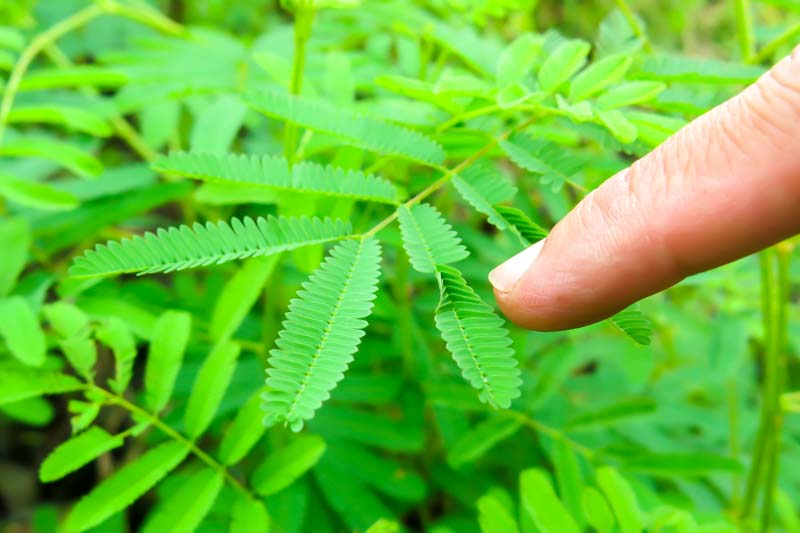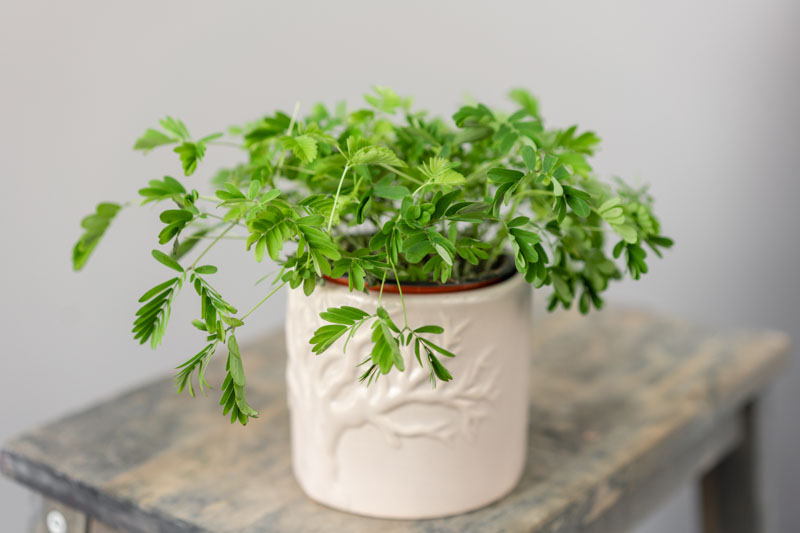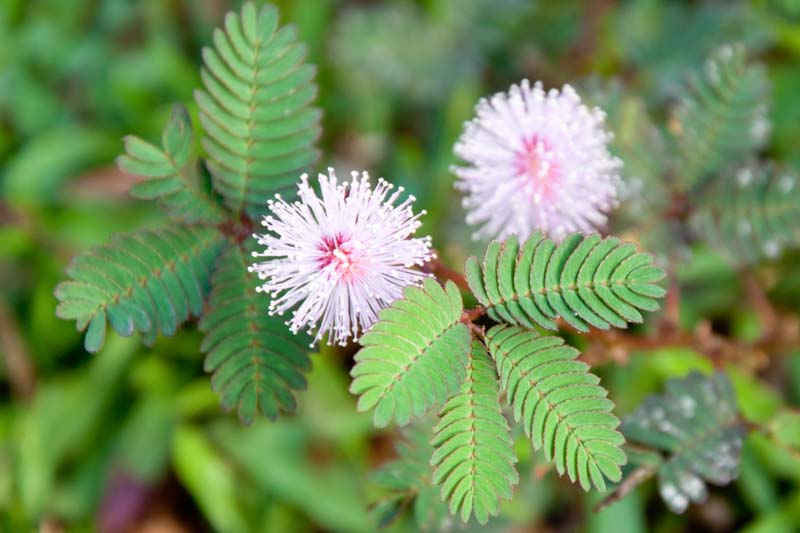Sensitive Plant, Sleepy Plant, Action Plant, Touch-me-not, Shameplant
Mimosa pudica, commonly known as the Sensitive Plant or Touch-Me-Not, is a fascinating and distinctive plant well-known for its rapid movement in response to touch or disturbance. With its unique behavior, this small, herbaceous plant has captivated people’s interest for centuries.
Mimosa pudica displays small, fern-like leaves that quickly fold inward and droop when touched or shaken, reopening minutes later. The plant has thorny stems and produces fluffy, ball-shaped pink or purple flowers.
Native: This plant is native to the Caribbean, South, and Central America but has become naturalized in many tropical regions worldwide due to its widespread cultivation and use. It belongs to the legume family (Fabaceae), which includes peas and beans.
Plant Type and Habit: It is a spiny annual or short-lived evergreen perennial that exhibits a creeping or trailing with age.
Size: Mimosa pudica typically grows to about 18 inches in height (45 cm) and spreads 12-60 inches (30-150 cm), depending on its growing conditions.
Flowers: The flowers are fluffy, globular, pink to lavender in color, and appear on stalks above the foliage, blooming from early to late summer. After flowering, the plant produces small, legume-like pods that contain seeds. The pods are prickly and burst open when ripe, scattering the seeds.
Foliage: Its leaves are bipinnate, green, and comprised of numerous small leaflets. They are borne on thorny stems. The rapid folding action of the leaves in response to touch is a defense mechanism against predation. The foliage also closes during darkness and reopens in light.
Hardiness: The Sensitive Plant is hardy in USDA zones 10 to 12. In cooler climates, it is often grown as an annual or indoors as a houseplant.
Uses: Mimosa pudica, with its touch-sensitive foliage, finds uses across various domains. Outdoors, it’s employed as a ground cover or for its soil stabilization capabilities. Indoors, it is used in terrariums and serves as a unique, air-purifying houseplant that sparks curiosity and conversation. In traditional medicine, it’s utilized for its purported healing properties in treating wounds and digestive issues.
Toxicity: Mimosa pudica is not considered highly toxic but can cause mild irritation if ingested by pets or humans.
Invasiveness: In some tropical and subtropical regions, Mimosa pudica can become invasive, spreading rapidly and dominating native plants. It is considered an invasive species in Tanzania, South and Southeast Asia, and many Pacific islands.
Benefits: Apart from its entertainment value, mimosa pudica can help in soil stabilization and erosion control in some areas. It also participates in nitrogen fixation, enriching the soil by converting atmospheric nitrogen into a form that plants can use, thus improving soil fertility without chemical fertilizers.

Growing and caring for the Sensitive Plant requires understanding its unique needs. This fascinating plant, famous for its touch-sensitive leaves, thrives both indoors and outdoors with proper care.
Light: Provide bright, indirect light. A south or east-facing window is ideal. Too much direct sunlight can scorch the leaves, while insufficient light may hinder growth.
Soil: Use a well-draining, rich potting mix with a slightly acidic to neutral pH.
Water: Keep the soil consistently moist but not waterlogged. Mimosa pudica is sensitive to over and under-watering. Using a pot with drainage holes can help prevent excess water.
Humidity: This plant loves high humidity. Regularly misting the plant or placing it on a pebble tray with water can help meet its humidity requirements.
Temperature: It prefers warmer temperatures, ideally between 65-75°F (18-24°C). Avoid placing it near cold drafts.
Feeding: Mimosa pudica, flourishing in low-nutrient environments, requires minimal fertilization. If enhancing growth is desired, a half-strength, high-potassium liquid fertilizer can be applied every few weeks during the growing season to support its health and vibrant flowering without overwhelming the plant.
Location: Plant in a spot with partial shade to protect it from the intense midday sun. It can tolerate more sun in cooler climates.
Soil: Ensure the soil is well-draining and enriched with organic matter. Mimosa pudica prefers a slightly acidic to neutral pH.
Watering: Similar to indoor care, the soil should be kept moist but not waterlogged. However, outdoor plants may require more frequent watering due to increased evaporation.
Protection: In areas with cooler temperatures, consider growing Mimosa pudica in pots that can be brought indoors during colder months.
Pruning: Trim the plant to encourage bushier growth. Pruning is especially helpful if the plant becomes leggy.

Propagating the Sensitive Plant can be a fun and rewarding process. The plant can be propagated both from seeds and through cuttings.
Seed Preparation: Mimosa pudica seeds have a hard outer coating. To increase germination rates, scarify the seeds by gently rubbing them with sandpaper or nicking the seed coat with a knife. Then, soak the seeds in warm water for 24 hours to soften the coat further.
Sowing: Plant the seeds in a well-draining seed starting mix, placing them about 1/4 inch deep. Keep the soil moist but not waterlogged.
Environment: Place the pot in a warm, bright spot but out of direct sunlight. A temperature around 70°F (21°C) is ideal for germination.
Germination: Seeds should germinate within 1-4 weeks. Keep the soil consistently moist during this period.
Care for Seedlings: Once seedlings emerge, ensure they receive bright, indirect light. Thin the seedlings if they become overcrowded, and continue to keep the soil moist.
Cutting Selection: Choose a healthy, non-flowering stem from the plant. Cut a 4-6 inch piece, making sure it has at least two sets of leaves.
Preparation: Remove the leaves from the bottom half of the cutting to expose the nodes.
Rooting: Dip the cut end into rooting hormone powder to encourage root growth. Plant the cutting in a moist, well-draining potting mix.
Environment: Cover the pot with a plastic bag or place it in a propagator to maintain high humidity, ensuring the plastic does not touch the leaves. Place in bright, indirect light.
Root Development: Roots should develop within a few weeks. Check for rooting by gently tugging on the cutting; resistance indicates root growth.
Aftercare: Once roots are established, remove the plastic cover and continue to care for the plant as usual, with regular watering and bright, indirect light.

The Sensitive Plant is generally robust but can encounter several pests, diseases, and common issues under suboptimal conditions. Awareness and early intervention can keep your plant healthy.
Spider mites: Indicated by fine webbing on the plant and speckled discoloration on leaves. They thrive in dry conditions.
Mealybugs: Look for cotton-like masses in leaf axils or on the undersides of leaves. They suck sap, weakening the plant.
Aphids: These small, sap-sucking insects can cluster on the undersides of leaves, causing yellowing and distortion.
Root rot: Overwatering or poor drainage leads to root rot, indicated by wilting, yellowing leaves. Ensure well-draining soil and moderate watering.
Powdery mildew: Appears as white, powdery spots on leaves in humid conditions. Improve air circulation, reduce leaf wetness, and treat with fungicides if necessary.
Leaf Closure Failure: If the leaves stop responding to touch, it may be due to water stress, lack of light, or the natural aging of the plant. Ensure adequate water, light, and consider repotting if the soil is depleted.
Yellow Leaves: Can result from overwatering, under-watering, or nutrient deficiencies. Adjust watering practices and consider a balanced, water-soluble fertilizer.
Leggy Growth: Insufficient light can lead to spindly stems and sparse leaves. Move your plant to a brighter location with indirect sunlight.

Sensitive Plants (Mimosa pudica) are not particularly hard to keep alive if their basic care needs are met. They require consistent moisture, high humidity, warm temperatures, and bright, indirect light. While they have specific requirements, with attention to their watering, light, and humidity needs, they can thrive both indoors and outdoors in suitable climates.
While it’s fascinating to observe the Sensitive Plant’s leaves folding upon touch, the plant doesn’t “like” to be touched in the same way animals might enjoy physical contact. The movement is a defensive mechanism to deter predators or protect itself from harm. Frequent touching can stress the plant, so it’s best to do so sparingly.
Yes, a Sensitive Plant can be grown as an indoor plant, especially in regions that do not mimic its native tropical habitat. Indoors, it requires bright, indirect sunlight and may benefit from supplemental humidity to mimic the moist, warm conditions it prefers.
It’s called a Sensitive Plant because of its rapid movements — the leaves fold inward and droop when touched, shaken or exposed to heat, reopening minutes later. This sensitivity to physical stimuli is where it gets its name.
While touching a Sensitive Plant occasionally is unlikely to cause significant harm, doing so frequently can stress the plant. The movement consumes energy, and repeated triggering can divert energy away from growth and health. Moreover, excessive handling can potentially damage the plant’s delicate stems and leaves. It’s a remarkable feature evolved as a defense mechanism rather than for regular interaction.
| Hardiness |
10 - 12 |
|---|---|
| Plant Type | Annuals, Houseplants, Perennials |
| Plant Family | Fabaceae |
| Exposure | Full Sun, Partial Sun |
| Season of Interest |
Spring (Early, Mid, Late) Summer (Early, Mid, Late) Fall Winter |
| Height |
1' - 2' (30cm - 60cm) |
| Spread |
1' - 5' (30cm - 150cm) |
| Maintenance | Low |
| Water Needs | Average |
| Soil Type | Loam |
| Soil pH | Acid, Neutral, Alkaline |
| Soil Drainage | Moist but Well-Drained |
| Characteristics | Showy, Evergreen |
| Garden Uses | Ground Covers, Patio And Containers |
| Hardiness |
10 - 12 |
|---|---|
| Plant Type | Annuals, Houseplants, Perennials |
| Plant Family | Fabaceae |
| Exposure | Full Sun, Partial Sun |
| Season of Interest |
Spring (Early, Mid, Late) Summer (Early, Mid, Late) Fall Winter |
| Height |
1' - 2' (30cm - 60cm) |
| Spread |
1' - 5' (30cm - 150cm) |
| Maintenance | Low |
| Water Needs | Average |
| Soil Type | Loam |
| Soil pH | Acid, Neutral, Alkaline |
| Soil Drainage | Moist but Well-Drained |
| Characteristics | Showy, Evergreen |
| Garden Uses | Ground Covers, Patio And Containers |
How many Mimosa pudica (Sensitive Plant) do I need for my garden?
| Plant | Quantity | |
|---|---|---|
| Mimosa pudica (Sensitive Plant) | N/A | Buy Plants |
Create a membership account to save your garden designs and to view them on any device.
Becoming a contributing member of Gardenia is easy and can be done in just a few minutes. If you provide us with your name, email address and the payment of a modest $25 annual membership fee, you will become a full member, enabling you to design and save up to 25 of your garden design ideas.
Join now and start creating your dream garden!
Create a membership account to save your garden designs and to view them on any device.
Becoming a contributing member of Gardenia is easy and can be done in just a few minutes. If you provide us with your name, email address and the payment of a modest $25 annual membership fee, you will become a full member, enabling you to design and save up to 25 of your garden design ideas.
Join now and start creating your dream garden!